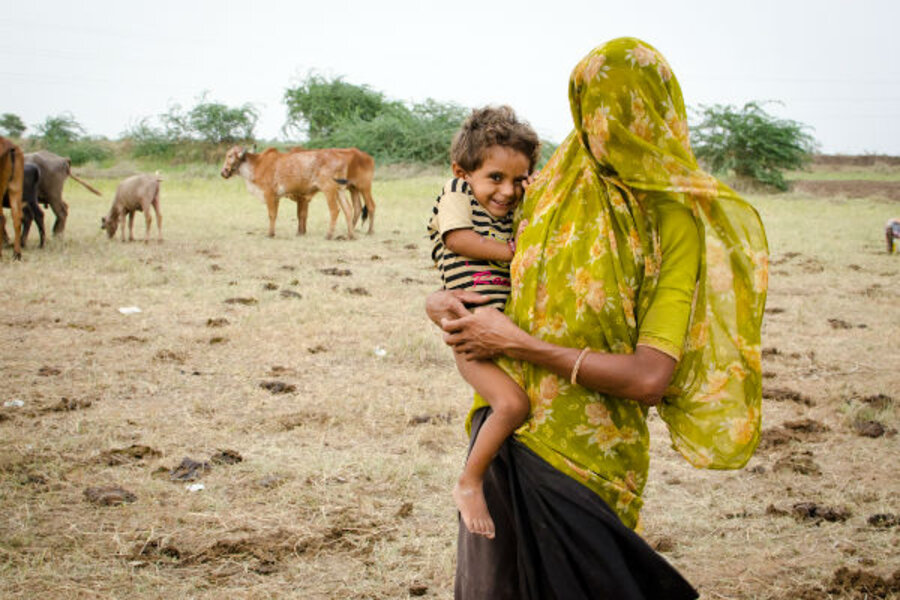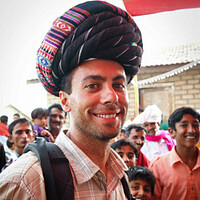Drought in India: Disrupted rhythms of nomadic family life
Loading...
| Ahmedabad, India
I've been catching the reports that the drought in the western United States is the worst to hit the region since the Dust Bowl years; how farmers are struggling; how livestock is suffering. The situation is similar where I've been traveling: in the Indian state of Gujarat, where some places are drier than they've been in decades.
The monsoon season, which usually soaks Gujarat with rain from mid-June through August, is a key element of the rhythm of life here: it waters farms, grasslands, and forests, fills cisterns and lakes, and cultural traditions and social rituals are timed to sync with it. But this year, it's simply failed to materialize in some regions, causing inconvenience for some, panic for others - especially those who rely on agriculture.
Among those hardest hit are families from the Maldhari tribes, some 5 million people including the Rabaris and Bharwads, who herd cattle, camels, sheep, and goats. Though many Maldharis migrate for half the year or more, moving from place to place in search of fodder for their animals, most return to their home villages for a few months (from about July to November) during and after the annual monsoon, as the grasses grow lush from the rain.
Traveling in August through the Saurashtra region, which has received less than 20 percent of its average annual rainfall, I could easily see the impact of the drought. Along the asphalt roads that traverse a flat patchwork of fields and open spaces, dotted occasionally with trees, thousands of cows and water buffaloes were marching, steered by men in turbans who wore thick silver bracelets, gold earrings, and carried large bamboo sticks. And they were heading away from their villages. There was simply no fodder for their animals near their homes.
I was with Lalji Desai, a member of the Rabari tribe who works with the non-profit Maldhari Rural Action Group (MARAG) and is secretary general of the World Alliance of Mobile Indigenous Peoples, an international organization that promotes pastoralists' rights and supports their cultures. He wanted to see the drought situation for himself, and how these organizations might help. Not long before sunset one day, when we saw a small Maldhari camp in a patch of land off the side of the road, we stopped to talk.
At a glance, it was hard to believe this was a camp. There were no tents or shelters of any kind, just a few of the typical woven cots known as charpais, out in the open, covered with quilted cotton blankets. Beside them were a clutter of brass and steel pots, jugs and bowls, and a stack of rice sacks filled with other belongings. Eight cute calves hovered around the charpais, looking like they were trying to figure out if they could rest on them.
Only five women were in the camp, plus a child of about two years old. The men who'd accompanied them were still out with their herd of cows.
About 50 miles from their village, they were heading away from it as slowly as possible. They'd tarried here for about a week, hoping that the rains would start so they could turn around and go home. But the grass here was running out, and they thought they'd probably have to move again in the next few days.
Friendly and eager to chat, the women insisted we sit and have tea, and we gladly obliged.
The women all wore lehenga cholis – long skirts with halter tops and headscarves. Three looked to be in their 20s, one in her late 30s, and another in her 50s. All had gold nose rings and earrings, silver rings on their toes, and flip-flops on their feet. A couple of them wore the Hindu bindi on their foreheads, and the forearms and hands of the eldest two were covered with geometric tattoos.
A pot was balanced atop three stones, with twigs ignited beneath it to cook the tea.
They were no strangers to the road, usually migrating for more than half the year, they told us, settling into an easy banter in Gujarati with Lalji, who translated.
"Every day a new village; every day a new fire hearth; every day a new well," said Puriben Rozia, who was dressed in vivid orange and spoke in animated tones. Though they are nomadic, she said, they always look forward to going home.
Jivanben, from the same family as Puriben, laughed and said, "For most of the year I live with my husband's family, but I always return to my parents' village during monsoon – and look where I am instead, sleeping in a field!"
She was in charge of the tea, which was classic Indian chai, made with milk from their own cows and dosed with plenty of sugar. It was served in typical Maldhari fashion – in saucers, which are easier to pack and travel with than cups.
Meanwhile, the patriarch of the family, Amrabhai Rozia, who was father-in-law of three of the women, arrived, just in time for chai. Puriben, along with her sisters-in-law Lavuben and Rajuben, held their headscarves out and at an angle, like gauzy walls between them and Amrabhai. In this region, social custom demands that women Maldharis hide their faces from their husband's fathers, uncles, and older brothers, as a show of respect. But they kept on talking while Amrabhai sat silently sipping his chai.
Lavuben, who looked to be in her late 20s, said that this was the first time in her life that there had been a "special migration" due to drought during monsoon season. On their usual migration, the whole family travels together, but this time she'd only brought her two-year-old and left her three other children – ages 4, 6, and 7 – back in the village; one was with her mother, one with her mother-in-law, and one with her brother-in-law.
"We took the cattle, they kept the kids," she said.
Life on the road is tough, and they'd already traveled for eight months solid "which is why they don't go to school," Lavuben added. It was better for them to have some time to rest and stay in one place.
Puriben agreed. She had left two children behind.
Lalji, sympathetic, said it must be difficult to be without them.
It was, Lavuben nodded, but she knew it was better for them to be home.
"And maybe we'll get to go back soon," she said. "We call every day on our mobile phones to check in. And the first thing we ask is, 'Is there rain?'"








